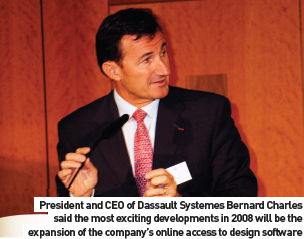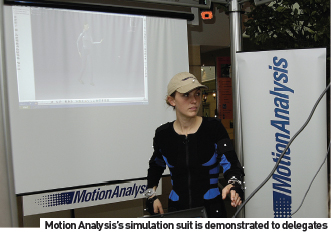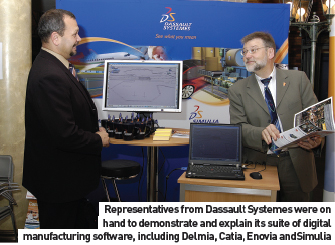Delegates got together in Stuttgart, Germany in October for the annual Delmia European Customer Conference to hear, see and learn about the latest offerings in digital manufacturing
Delmia held its European Customer Conference in Stuttgart on October 6 and 7 and the event was well attended, with more than 350 delegates listening to presentations from users, attending workshops and visiting the small but fascinating exhibition which ran concurrently with the conference. Major industries represented by speakers and workshop leaders included: automotive, aerospace, mechanical engineering, electrical and electronics, fabrication and assembly, consumer goods and shipbuilding.
On the first day, delegates shared current projects and successes and heard presentations from vehicle makers and engineers from aerospace and other industries. At the end of the presentations, delegates were invited to join networking/round table discussions divided by geography and topic. Specific topics included aerospace suppliers (Saab), automotive suppliers (OEM-Suppliers and collaboration) and the benefits and justification of digital manufacturing projects.
 The second day was more user-orientated, and focused on actual user case studies, with workshops on applications in various industries running side-by-side. Sponsors and exhibitors included Hewlett Packard, Intercim, IBM, T-Systems (part of Deutsche Telekom), Cenit, Transcat, Motion Analysis, Haption, Dassault Systemes and Delfoi.
The second day was more user-orientated, and focused on actual user case studies, with workshops on applications in various industries running side-by-side. Sponsors and exhibitors included Hewlett Packard, Intercim, IBM, T-Systems (part of Deutsche Telekom), Cenit, Transcat, Motion Analysis, Haption, Dassault Systemes and Delfoi.
Exhibits included demonstrations of software, interactive motion control mapping programmes, and, one of the highlights, an ergonomic bodysuit worn by a demonstrator to show the analysis of body movement in various assemblytype functions.
Proceedings got under way with an introduction from Bernard Charlés, President and CEO of Dassault Systemes, who highlighted the company’s activities and customers in various sectors. One of the most exciting developments in 2008 will be the expansion of the company’s online access to design software. Charlés underlined the enormous design power that will be available to its customers’ teams who could be situated anywhere around the globe but can all log on to common software platforms and work interactively.
Philippe Charlés then outlined Delmia’s specific offerings; the division’s ‘holistic’ approach for production performance, offering one environment with single V5 desktop, collaborative digital production engineering and creation and validation tools. The area of body-in-white is seeing major developments in Delmia’s suite of products and it is working towards extending capabilities for production implementation. He also spoke of using tools such as V5R18 to produce interactive ‘loops’ to reproduce lines and enable line planning and balancing, seeking out production clashes and finding ‘dead’ areas and using them for process optimisation.
The first presentation was made by Herbert Kircher, Managing Director of IBM Germany’s Development Laboratory. He gave a fascinating insight into how the rapid pace of new technology is impacting on business. The presentation described some of the fundamental future trends in IT and their impact on all industrial sectors. He talked of emerging software, hardware, and services that are expected to significantly impact IT users in the next three to seven years.
Kircher spoke about technologies and innovation which are disruptive to existing approaches, and those which may generate new business opportunities. He identified trends, challenges and growth opportunities in the following areas: server and chip technology, IT infrastructure and internet technologies and the internet of the future.
 Honda’s case study: front-loading using PLM
Honda’s case study: front-loading using PLM
The first of the speakers representing vehicle makers was Akira Namiki, Senior Staff Engineer of Production Engineering at Honda of Japan. He spoke on the PLM strategy used by of Honda, from a manufacturing (monotsukuri) point of view.
Namiki showed a multi-faceted example of how the vehicle maker achieves front-loading using PLM. His presentation also described how this output connects activities and disseminates information globally from the early design phase throughout the production ramp-up phase, thereby fostering enhanced communication.
He showed a video illustrating various ergonomic studies using virtual figures, fitting vehicle interior components to illustrate the 3D to 7D concept – 3D solid giving the expression of posture; 4D – process, 5D – knowledge, 6D – individual, unique body types and 7D – virtual ‘superreality’, called waku-waku.
A very interesting part of his presentation was the demonstration of the use of virtual light modelling, simulating light patterns to find shadowed areas on the line – under the vehicle during exhaust fitting in this case.
Jan-Hendrik Theilen, a manufacturing engineer from Volkswagen in Wolfsburg, talked of the effects of rising quality requirements, shortening lead times, rising cost pressures and increasing needs for press shop efficiency on manufacturing, and how Volkswagen Werkzeugbau Wolfsburg places greater emphasis on optimising car body part designs towards costs and manufacturability in the early stages of product development.
The unit develops the manufacturing process of car body parts for the globally-distributed production locations of the Volkswagen Group. The process development is conducted in cooperation with the internal and external die manufacturers of the Group. A main focus is the assurance of quality, cost and schedule targets in the early stages of process engineering.
The fulfilment of these targets demands an early digital analysis of the production process and optimisation of product designs from the manufacturing perspective.
Theilen spoke of the crucial importance of establishing new ways of organising process engineering to realise these goals.
The development project “PLM-Strategie Presswerk” strives not just for assuring the parameters of the production facility but also for assuring these parameters in an integrated digital copy of the physical manufacturing process. Theilen went on to illustrate the necessity of analysing product data concerning formability and material flow, and showed the use of several Delmia virtual production tools.
Workshops were held on day two, and these included an interesting focus on ergonomics from Maileen Zander an ergonomics engineer from Volkswagen Wolfsburg.
Her presentation, ‘Ergonomic Analysis and Evaluation of Workplaces with DELMIA V5 Human at Volkswagen’ highlighted the importance that the carmaker places on ergonomics and discussed how changing demographics have forced improvements of future assembly workstations, and how this had stimulated work with DELMIA V5 Human in the assembly planning department.
She expanded on how the different analyses are made with this tool:
- In the early product development process simulations are executed, checking reachability and visibility in the environment of the employee. Late changes and costs can be avoided by validating redesigns.
- The strain on an employee can be simulated with different methods of analysis. For example, RULA (Rapid Upper Limb Assessment) is used to evaluate body positions according to the ‘traffic light principle.’
- Enquiries from production can be also accomplished.
 Estimates can be evaluated if planned changes bring the expected success so that applying costs can be justified.
Estimates can be evaluated if planned changes bring the expected success so that applying costs can be justified.
For example, a health related improvement of the work environment can be achieved. The reuse of tools, fixtures and jigs can also be checked.
- In the future it should be possible to play simulations in real time.
- Illustrations were presented of the development of a link to DELMIA Process Engineer.
- In the future it will be possible to carry over assembly paths from other tools into DELMIA Human, for example a force feedback system can be used to simulate the weight of a component.
Further workshops saw presentations from Audi on a virtual body shop, digital validation of robot cells from Daimler and line balancing in wire harness production from Tier One supplier Valeo, among others.


































